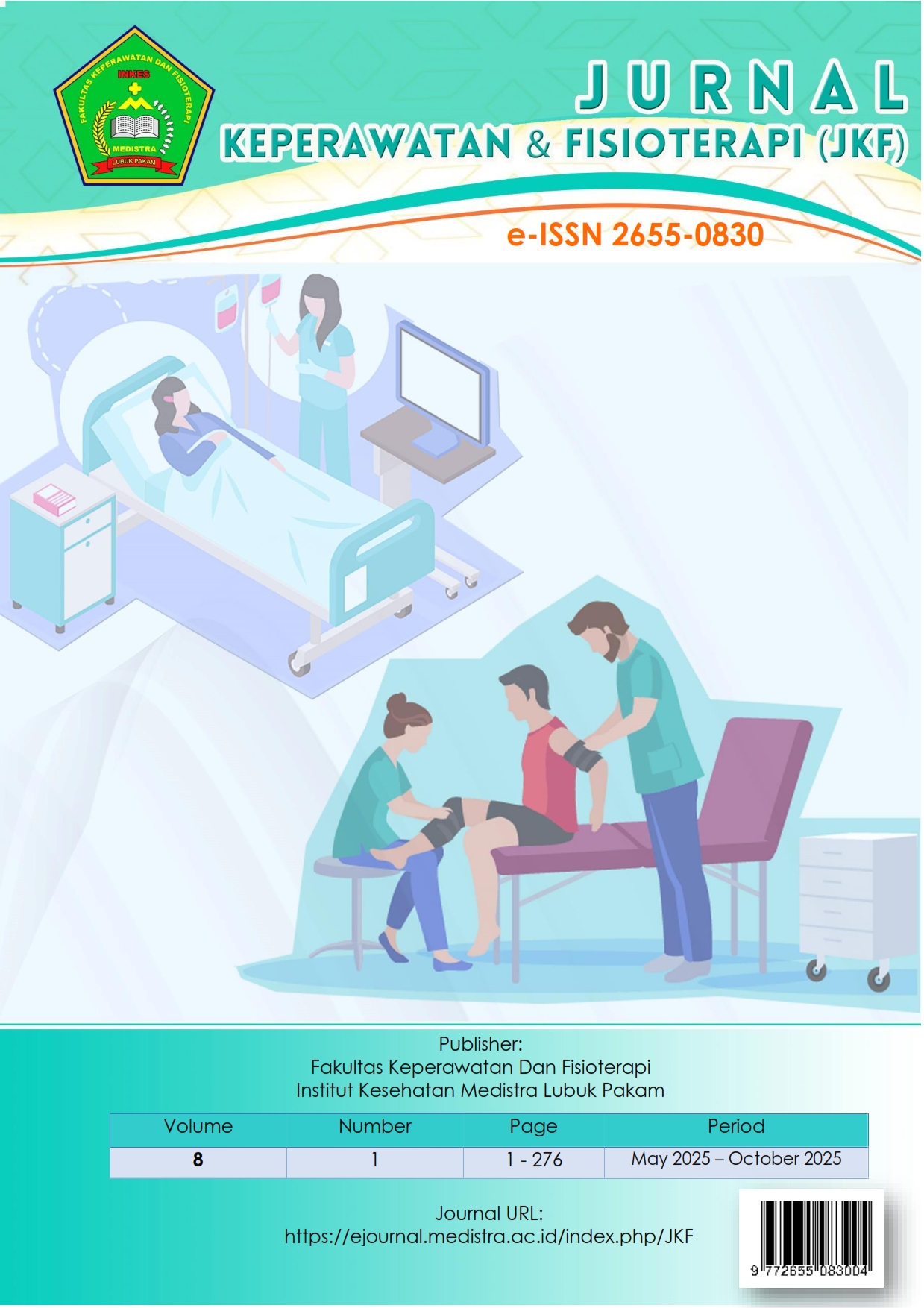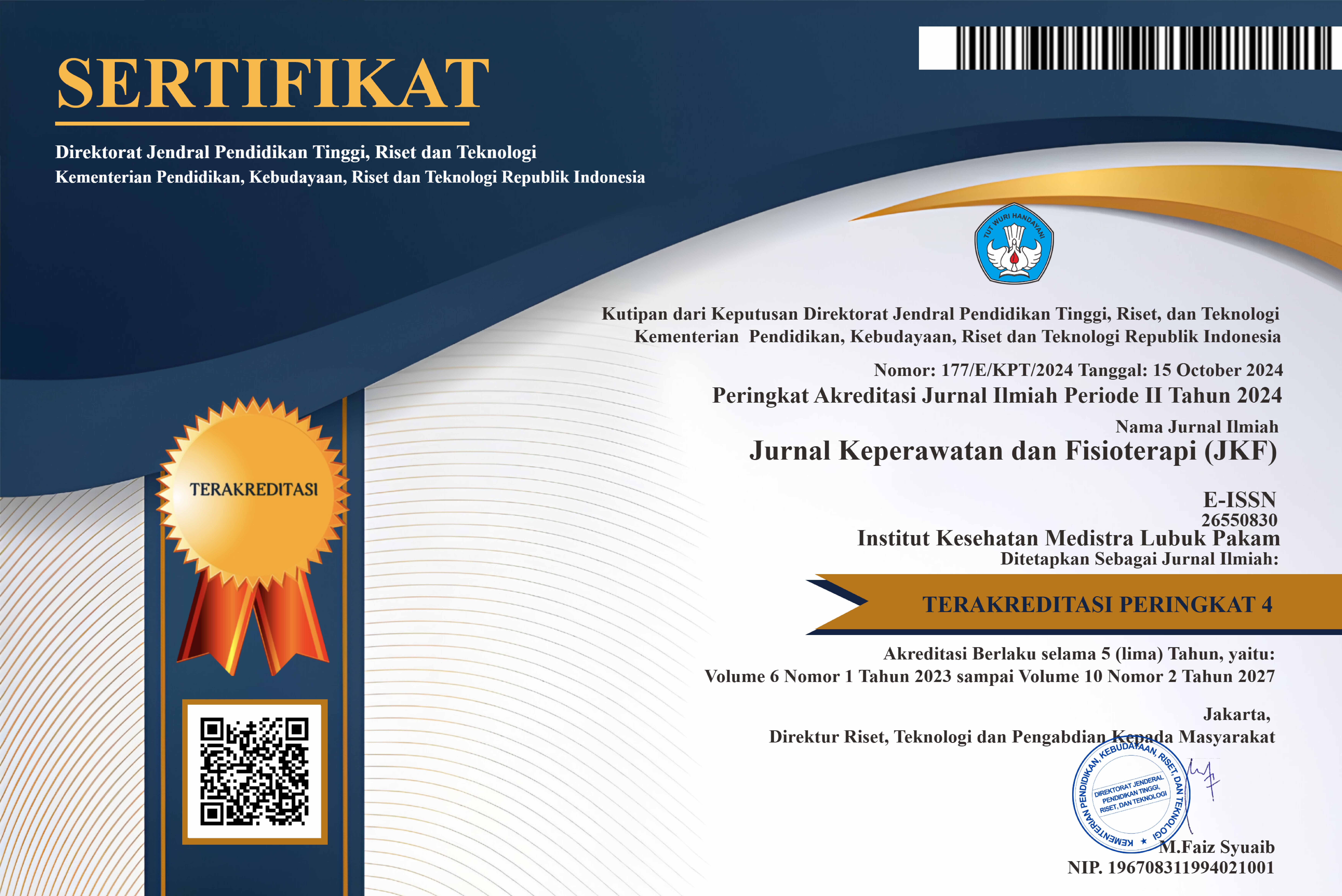Physiotherapy Management of Left Anterior Cruciate Ligament (ACL) Injury Using Electrical Stimulation and Exercise Therapy at ABR Physiotherapy Clinic, Bojonegoro
DOI:
https://doi.org/10.35451/489va465Keywords:
Post-operative Anterior Cruciate Ligament (ACL), Electrical Stimulation (ES), Therapeutic ExerciseAbstract
Anterior Cruciate Ligament (ACL) injuries are commonly caused by non-contact mechanisms related to muscle imbalance in supporting the knee, decreased flexibility, reduced muscle strength and endurance, poor joint coordination, and external pressure. ACL injuries can be treated operatively through reconstructive procedures. However, post-operative conditions following ACL reconstruction often lead to complications such as pain, inflammation, muscle atrophy, limited range of motion (ROM), and decreased lower limb muscle strength, which can delay functional recovery. Physiotherapy plays a crucial role in the rehabilitation process to restore knee function. This study aims to describe the physiotherapy management in post-operative ACL patients in reducing pain, improving muscle strength, enhancing joint range of motion, and increasing functional activity. The method used was a case study involving one post-operative ACL patient at ABR Physiotherapy Clinic in Bojonegoro who underwent therapy from January 6 to January 23, 2025. Interventions included Electrical Stimulation (ES) and therapeutic exercise, with data collected using the Numerical Rating Scale (NRS), Range of Motion (ROM), segmental circumference, Manual Muscle Testing (MMT), and the Lower Extremity Functional Scale (LEFS). The results showed a decrease in tenderness pain from a score of 2 to 0, motion pain from 2 to 0, an increase in knee flexion from 120° to 130°, extension from 10° to 5°, an improvement in muscle strength from 4 to 5 in the left knee, and an increase in functional activity score from 40 to 41. The conclusion of this study is that Electrical Stimulation and therapeutic exercise are effective in reducing pain, improving range of motion, enhancing muscle strength, and increasing functional activity in post-operative ACL patients.
Downloads
References
[1] L. Petterson, *Sport Injuries: Prevention, Treatment, and Rehabilitation*, Boca Raton: CRC Press, 2016.
[2] M. Pattnaik, *The Knee for Physiotherapists*, Sidoarjo: BFS Medika, 2022.
[3] L. Peterson, *Sports Injuries*, 2016.
[4] D. Joyce and D. Lewindon, *Sport Injury Prevention and Rehabilitation*, New York: Routledge, 2016.
[5] N. Singh, "International Epidemiology of Anterior Cruciate Ligament Injuries," *Orthopedic Research Online Journal*, vol. 1, no. 5, pp. 94–96, 2018. [Online]. Available: https://doi.org/10.31031/oproj.2018.01.000525
[6] M. Dhuhairi, R. Kurniawan, and S. Budianto, “Prevalensi Cedera Lutut pada Atlet di Indonesia,” *J. Kedokteran Olahraga Indonesia*, vol. 4, no. 1, pp. 22–27, 2021.
[7] H. Anshari, D. N. Astuti, and J. K. Pertiwi, “Penatalaksanaan Fisioterapi Pada Post Rekonstruksi Anterior Cruciate Ligament Dengan Modalitas Terapi Latihan, Cryotherapy, dan Neuromuscular Electrical Stimulation,” *Jurnal Fisioterapi Indonesia*, vol. XXIV, no. 2, pp. 41–48, 2024.
[8] F. A. Syafa’at and E. Rosyida, “Pemulihan Pasien Pasca Rekonstruksi Anterior Cruciate Ligament Dengan Latihan Beban,” *Jurnal Fisioterapi Indonesia*, vol. XX, no. 1, pp. 67–72, 2020.
[9] J. Chuanjia, J. Jiao, J. Zhou, B. Chow, Q. Shi, X. Zhang, S. Liu, and J. Yang, “Three-Month Functional Training Programme Improves Knee Joint Function in Athletes Post ACL Reconstruction Surgery,” *Journal of Rehabilitation Medicine*, vol. 56, 2024.
[10] Kementerian Kesehatan Republik Indonesia, *Peraturan Menteri Kesehatan Republik Indonesia Nomor 80 Tahun 2013 tentang Penyelenggaraan Praktik Fisioterapis*, 2013.
[11] Kementerian Kesehatan Republik Indonesia, *Peraturan Menteri Kesehatan Republik Indonesia Nomor 65 Tahun 2015 tentang Standar Pelayanan Fisioterapi*, 2015.
[12] S. Cho, J. Kim, S. Nam, H. Moon, and W. Jung, “Effects of a Rehabilitation Exercise Program Using Electro Muscle Stimulation following Anterior Cruciate Ligament Reconstruction on the Circumference, Activity, and Function of the Quadriceps Muscle,” *Applied Sciences (Switzerland)*, vol. 13, 2023.
[13] J. Ardianto, “Penatalaksanaan Fisioterapi Pada Kondisi Pasca Operasi Rekonstruksi Anterior Cruciate Ligament Sinistra,” *Jurnal Fisioterapi Indonesia*, vol. XXII, no. 7, pp. 71–75, 2023.
[14] H. A. Hendrik, “Efektivitas Electrical Stimulation terhadap Nyeri Lutut pada Kasus ACL,” *Jurnal Terapi Elektro Medik*, vol. 12, no. 1, pp. 32–37, 2024.
[15] American Physical Therapy Association (APTA), *Principles of Therapeutic Exercise*, 4th ed., New York: APTA Press, 2015.
[16] C. Wang, “Therapeutic Exercise and Muscle Strength Gain in Post-ACL Injury,” *International Journal of Physiotherapy*, vol. 9, no. 1, pp. 45–50, 2024.
[17] F. A. Syafa’at and E. Rosyida, “Pemulihan Pasien Pasca Rekonstruksi Anterior Cruciate Ligament Dengan Latihan Beban,” *Jurnal Fisioterapi Indonesia*, vol. XX, no. 1, pp. 67–72, 2020.
Downloads
Published
Issue
Section
License
Copyright (c) 2025 Halim Warda, Dimas Arya Nugraha, Diah Rosyida Maulidina

This work is licensed under a Creative Commons Attribution 4.0 International License.
Copyright in each article is the property of the Author.


























